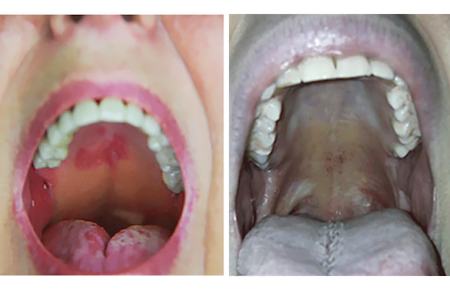Pityriasis rosea: Signs and symptoms
Pityriasis rosea is a common condition, which causes a harmless rash on the skin. The rash usually lasts 6 to 8 weeks before disappearing, but it can last longer.
Where does pityriasis rosea appear on the body?
The rash can develop anywhere on the skin or scalp. However, it usually begins on the chest, abdomen, or back and spreads. As it spreads, it may reach the upper arms or legs.
If you have inverse pityriasis rosea, the rash usually develops in the armpits, groin, and sometimes the face or neck. Young children and people who have deeply pigmented skin are more likely than others to develop inverse pityriasis rosea.
While rare, some people also develop spots and patches in their mouth.
What does pityriasis rosea look like and feel like?
What people feel and see on their skin can differ. The following explains how pityriasis rosea tends to develop and progress.
Herald patch appears
It’s common to develop a single herald patch on your skin. This patch is usually oval or round and slightly raised. On lighter skin tones and olive skin, it’s pink to salmon in color and often has fine scale in the center (A). People with deeply pigmented skin often see a herald patch (usually gray, violet, or brown) and small bumps appear at the same time (B).

Herald patch grows
For a few days to 2 weeks, the herald patch may be the only sign of pityriasis rosea on your skin. During this time, the patch grows, often to about an inch in diameter (A), but some can reach 4 inches in diameter. While rare, some people develop 2 or more herald patches (B).

A widespread rash appears
Within a week or two of seeing the herald patch, many people develop a widespread rash, often called “daughter patches.” These patches are smaller than the herald patch and may appear anywhere on your skin. They’re most common on the trunk, legs, and arms. Your skin may itch, especially if it becomes warm, such as during a workout or a hot shower.

The rash can look like another skin condition
While the rash usually causes small, scaly bumps on the skin, the rash can look more like hives or ringworm (A). It can even look like acne (B) or one of many other skin conditions. A dermatologist can give you an accurate diagnosis.

Spots and patches inside mouth
This is rare. Some people develop a raised patch, bumps, spots, or other lesions inside their mouth. You may also have swollen lymph nodes in your throat. The lesions in your mouth will go away at about the same time the rash on your skin clears.

Itch or flu-like symptoms may develop
Not everyone develops itchy skin or flu-like symptoms. If you do, flu-like symptoms may include a sore throat, swollen lymph nodes, or fatigue.

Rash clears on its own, usually in 6 to 8 weeks
Once the rash appears, you may see a new rash every few days. For most people, the rash continues for 6 to 8 weeks, though it can last longer. Children’s skin tends to clear more quickly, usually in 16 days. Once the skin clears, many people never get pityriasis rosea again.

Dark or light spots on your skin
After the rash clears, you may see spots or patches on your skin that are lighter (hypopigmentation) or darker (hyperpigmentation) than your natural skin color. This tends to be more noticeable in people who have darker skin tones. These spots and patches will clear on their own, but it can take months.

Patients often ask their dermatologist why they developed pityriasis rosea. To see what researchers have discovered, go to Pityriasis rosea: Causes.
Images
Images 1, 11, 12: Getty Images
Images 2, 3, 4, 7, 8: Produced with permission from ©DermNet www.dermnetnz.org 2024.
Images 5, 6, 9, 10: Used with permission of the Journal of the American Academy of Dermatology:
J Am Acad Dermatol 2009;61:303-18.
J Am Acad Dermatol 2017;77:833-7.
References
Clark M, Gudjonsson JE. “Pityriasis rosea.” In: Kang S, Amagai M, et al. Fitzpatrick’s Dermatology (ninth edition). McGraw Hill Education, New York, 2019: 518-26.
Goldstein AO, Goldstein BG. (section editors: Dellavalle RP, Levy ML). “Pityriasis rosea.” UpToDate. Last reviewed: 8/2024. Last accessed: 9/2024.
Habif TP, Campbell JL, et al. “Pityriasis rosea.” In: Dermatology DDxDeck. Mosby Elsevier, China, 2006: Card 42.
Litchman G, Nair PA, et al. “Pityriasis rosea.” StatPearls. Last updated 3/1/2024. Last accessed 9/2024.
Wood GS, Reizner GT. “Other papulosquamous disorders.” In: Bolognia JL, et al. Dermatology. (fourth edition). Mosby Elsevier, China, 2018:170-2.
Written by:
Paula Ludmann, MS
Reviewed by:
Brendan Camp, MD, FAAD
William Warren Kwan, MD, FAAD
Ata Moshiri, MD, FAAD
Carla Torres-Zegarra, MD, FAAD
Last updated: 10/24/24
 Atopic dermatitis: More FDA-approved treatments
Atopic dermatitis: More FDA-approved treatments
 Biosimilars: 14 FAQs
Biosimilars: 14 FAQs
 How to trim your nails
How to trim your nails
 Relieve uncontrollably itchy skin
Relieve uncontrollably itchy skin
 Fade dark spots
Fade dark spots
 Untreatable razor bumps or acne?
Untreatable razor bumps or acne?
 Tattoo removal
Tattoo removal
 Scar treatment
Scar treatment
 Free materials to help raise skin cancer awareness
Free materials to help raise skin cancer awareness
 Dermatologist-approved lesson plans, activities you can use
Dermatologist-approved lesson plans, activities you can use
 Find a Dermatologist
Find a Dermatologist
 What is a dermatologist?
What is a dermatologist?